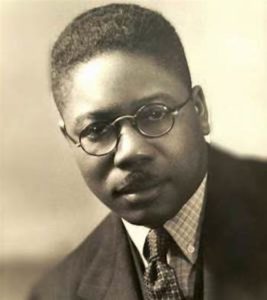
Aaron Douglas
On this date, we recall the birth of Aaron Douglas in 1899. He was a Black artist closely associated with the Harlem Renaissance.
Douglas came to Harlem from Topeka, Kansas, in 1925. Shortly after his arrival, Douglas was encouraged to develop his American Black aesthetic by drawing on design motifs in African art. Douglas created a unique aesthetic that linked Black Americans with their African past by using imagery derived from African sculptural and ancestral art to express aspects of the Black experience in the United States. Though he had been instructed in the academic mode of painting at the University of Nebraska, Douglas rejected realism in favor of a geometric style he developed during the late 1920s.
Douglas began his artistic career as an illustrator, working in black and white with an occasional touch of gray. He burst onto the art scene in 1925 with a cover illustration for Opportunity Magazine and a first-place award from The Crisis magazine for his drawing, The African Chieftain. Douglas's visual exploration of African motifs and his use of Black subjects commanded the attention of Black intellectual and writer James Weldon Johnson, who commissioned Douglas to illustrate his "God's Trombones: Seven Negro Sermons in Verse" (1927). Art collector and historian Albert C. Barnes offered Douglas a yearlong scholarship to study color at his art school outside of Philadelphia. Douglas, who had little experience mixing colors, accepted and began incorporating color in his murals.
Douglas is best known for the mural series "Aspects of Negro Life" (1934). Douglas was not exclusively an illustrator and muralist, although these two media occupied the majority of his career.
Douglas was also an educator. After graduating from the University of Nebraska, he taught art at Lincoln High School in Topeka, Kansas, from 1923 to 1925. He synthesized formal and symbolic elements of African art with a modern European aesthetic. Beginning in 1939, he occasionally taught drawing and painting at Fisk University.
After earning a master's degree in art education from Columbia University in 1944, he became a permanent member of the Fisk University faculty, serving as a professor and chair of the art department until his retirement in 1966. Douglas continued to lecture and paint until he died in 1979.
The biographical dictionary of Black Americans
by Rachel Krantz and Elizabeth A.Ryan
Copyright 1992, Facts on File, New York, NY
ISBN 0-8160-2324-7